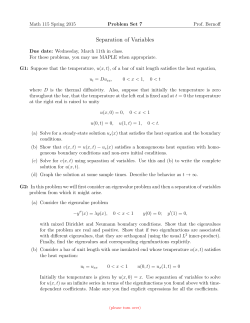
(SP): Definitions and Exampl
Stat 761 Winter 2015 Stochastic Processes Instructor: A. Swishchuk Lecture 25: Stationary Processes (SP): Definitions and Examples Outline ⇒ SP: Definitions ⇒ SP: Examples 1 SP: Definitions Def. 1. A stationary process is a stochastic process (X(t), t ∈ T ) with the property that for any positive integer k and any points t1 , t2 , ..., tn , and h in T, the joint distribution of (X(t1 ), ..., X(tk )) is the same as the joint distribution of (X(t1 + h), ..., X(tk + h)). Short Examples. 1. Electrical pulses in communication theory are SPs. 2. The spatial and/or planar distriutions of stars or galaxies are SPs. 3. Economic time series, such as unemployment, gross national product (GNP), national income, etc., are SPs. If the mean m(t) = E[X(t)] exists, it follows that this quantity must be constant, m(t) = m for all t. Similarly, if the second moment E[X(t)]2 is finite, then the variance σ 2 = E[(X(t) − m)]2 is a constant, independent of time. Let t and s be time points, and suppose, that t > s. Using the stationary property, we compute the covariance E[(X(t) − m)(X(s) − m)] = E[(X(t − s) − m)(X(0) − m)] such that the right-hand side depends only on the time difference t − s. If we define the covariance function, R(h) = E[(X(h) − m)(X(0) − m)], then E[(X(t) − m)(X(s) − m)] = R(|t − s|). Obviously, σ 2 = R(0). To standardize the covariance we introduce the so-called the correlation function or autocorrelation function, defined by ρ(v) = 1 R(v) = R(v)/R(0). σ2 Then ρ(0) = 1, and it can be shown (using Schwartz’ inequality) that −1 ≤ ρ(v) for all v. Def. 2. A covariance stationary process is a stochastic process (X(t), t ∈ T ) havinf finite second moments, E[X(t)]2 < +∞, a constant mean m = E[X(t)], and a covariance E[(X(t) − m)(X(s) − m)] that depends only on the time difference |t − s|. Other terms usedin the literature synonymously with covariance stationary are weakly stationary or wide-sense stationary, and what we have called s tationary process is often termed strictly stationary to emphasize the distinction. Every SP with the second moments is covariance stationary, and a covariance stationary process is not in general a stationary. Exception is only for Gaussian process, because its distribution is defined by the first two moments. 2 SP: Examples 1. Two Contrasting SPs i) A sequence Yi of i.i.d.r.v.s is a stationary process. If the variance is σ 2 then the process is covariance stationary, and the covariance function is 2 σ , f or v = 0, R(v) = 0, f or v 6= 0. ii) Let Z be a single r.v. with known distribution and set Z0 = Z1 = Z2 = ... = Z. This process is stationary. If the r.v. Z has a finite variance σ 2 , the the process is covarinace stationary, and the covariance function is R(v) = σ 2 . In this way, Yn and Zn are extremes and may be used toexemplify contrasting behavior of SPs. Observing Y1 , Y2 , ..., Yn provides no information that could be used to predict Yn+1 , while observing only Z0 enables Z1 , Z2 , ... to be predicted exactly. Here is a second way that the processes are opposites. Suppose the process Yn has a finite mean value function m. The by the LLN, the sample average Y0 + Y1 + ... + Yn n converges to the constant m = E[Y0 ]. No such convergence takes place in the Zn process. Indeed Z0 + Z1 + ... + Zn−1 = Z0 = Z n and there is just as much ’randomness’ in the nth sample average as there is in the first observation. 2. Trigonometrical Polynomials Let A and B be i.d.r.v.s having a mean of zero and variance σ 2 . We suppose that A and B are uncorrelated, i.e., E[AB] = 0. Fix a frequency ω ∈ [0, π] and for n = 0, ±1, ±2, ... define Xn = A cos(ωn) + B sin(ωn). Then E[Xn ] = 0 and E[Xn Xn+v ] = σ 2 cos(ωv). The process is covariance stationary. If A and B have a normal distributon with mean zero and variance σ 2 , the process is Gaussian and thus strictly stationary. 3. Moving Average Processes Let ξn , n = 0, ±1, ±2, ..., be uncorrelated r.v. having a common mean µ and variance σ 2 . Let a1 , a2 , ..., am be arbitrary real numbers and consider the process defined by Xn = a1 ξn + a2 ξn−1 + ... + am ξn−m+1 . We have E[Xn ] = µ(a1 + ... + am ), and V ar[Xn ] = σ 2 (a21 + ... + a2m ). The process is covariance stationary. 4. Stationary Markov Chains Let Xn be a stationary MC with stationary probability πi . This process is stationary process, as P (Xn = j) = πj and P (Xn = i, Xn+1 = j) = P (Xn = i)P (Xn+1 = j|Xn = i) = πi Pij , and so on. The joint distribution of (Xn , Xn+1 , ..., Xn+k ) does not depend on n. 5. Incremented Poisson Process Let X(t) := N (t + L) − N (t), t ≥ 0, L > 0−fixed constant, and N (t) is a Poisson process having rate λ. The stationary property follows from the stationary and independent increment assumption of the Poisson process, which implies that the continuation of a Poisson process at any time s remains a Poisson process. The same statement valid for standard Wiener process. Recommended Textbook: ’A First Course in Stochastic Processes’ by S. Karlin and H. Taylor, Academic Press, 2nd ed., 1975, Chapter 9, Sec. 1. Recommended Exercises: 1, p.525.
© Copyright 2025















